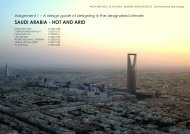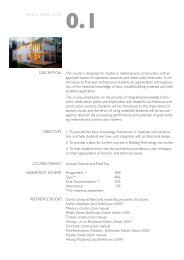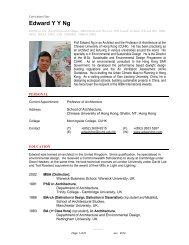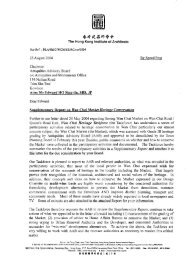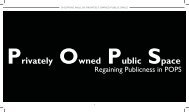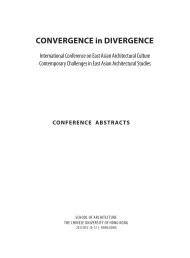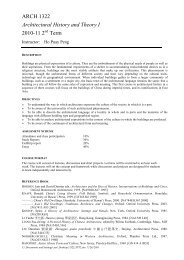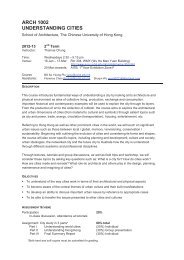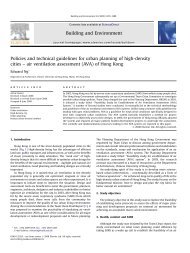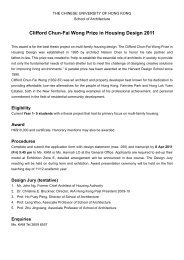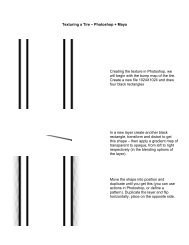Notebook III - School of Architecture - The Chinese University of ...
Notebook III - School of Architecture - The Chinese University of ...
Notebook III - School of Architecture - The Chinese University of ...
Create successful ePaper yourself
Turn your PDF publications into a flip-book with our unique Google optimized e-Paper software.
Design: product, form, and content<br />
studytype<br />
Studio project<br />
<strong>School</strong> project<br />
34 Design is not merely problem-solving. <strong>The</strong> scope<br />
Studio projects are occasions for study and<br />
<strong>School</strong> projects are formulated independently<br />
35<br />
exercise based on the studio as “positions,”<br />
not as dogma.<br />
<strong>of</strong> a solution to a problem is confined to its<br />
description. Design is an act <strong>of</strong> creating a new<br />
and concrete “fact.” It is related to needs, limits,<br />
potentials, and intentions. But it is not reducible<br />
to any such abstraction or produceable in direct<br />
response to them.<br />
<strong>The</strong> scope <strong>of</strong> the projects varies to suit the<br />
particular approach and pedagogical strategy<br />
<strong>of</strong> the studio. <strong>The</strong>y provide the possibility<br />
<strong>of</strong> exercises which are particularly suited to<br />
the issues in the studio. Beyond the daily and<br />
immediate educational objectives, the studies<br />
and their results make a cumulative contribution<br />
to an implicit discourse between different<br />
positions in architecture.<br />
However, in all studios the exercises remain<br />
as design exercises within the scope <strong>of</strong> architecture.<br />
<strong>of</strong> the studio positions and are occasions for<br />
the application <strong>of</strong> particular design positions<br />
to general designs. As in other parts <strong>of</strong> the<br />
programme they are not only statements <strong>of</strong><br />
“design projects,” but are themselves a way <strong>of</strong><br />
seeing and interpreting building types.<br />
At the simplest level, three kinds <strong>of</strong> places<br />
seem to define the human world: place <strong>of</strong><br />
work, place <strong>of</strong> gathering, and place <strong>of</strong> solitude.<br />
<strong>The</strong>y are the necessary elements <strong>of</strong> any<br />
complete human environment: the house, the<br />
school, the factory, the temple.



